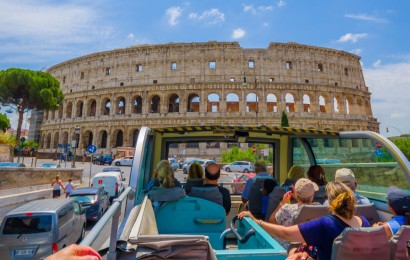The origins of the Ancient Roman Forum
In ancient times the forum was a swampy area, only at the end of the seventh century AD, the area was drained through the construction of the "Cloaca Maxima",one of the first sewage systems in the world.
With the reclamation of the area, the Roman Forum began to take life as a center of public life, administrative, political, economic and religious affairs, until it became the official meeting point of the Roman citizens during the Republican era.
Throughout its history, the Roman Forum has been adorned with buildings and monuments of extraordinary beauty : the Temple of Vesta, small and circular, the Temple of Antoninus Pius and Faustina, the Arch of Titus and Septimius Severus.
The Temple of the Dioscuri, the Basilica Giulia and the imposing Basilica of Maxentius placed in ancient times on the hill of Velia. In 608 A.D. was erected the last monument in the Forum, called Column of Phocas and built in order to honor the Roman Emperor of the East Phocas.
In the late ancient age, the Roman Forum goes through a phase of decline until it is used as pasture for cattle. It will be the Unification of Italy to restore light to the Forum, making it one of the most visited archaeological sites in the world.
The Roman Forum (called by the Romans "Forum Magnum") is currently the archaeological area of Rome between Piazza Venezia, the Colosseum, the Palatine and crossed by the Via dei Fori Imperiali.
Visit to Imperial Forums
The visit to Imperial Forums is the best way to visit ancient Rome and immerse yourself in the life of the ancient Romans. If you are planning a guided tour of the Colosseum and the Roman Forum, you cannot miss some of the wonders of the ancient Roman forum:
- Arch of Titus, is a triumphal arch, symbol of the Flavian period erected in memory of the Jewish war conducted by the emperor Titus in Galilee;
- Basilica of Maxentius and Constantine, is the largest civil basilica of the Roman forum, built by Maxentius in 308 A.D. and finished, by Constantine who defeated Maxentius in the battle of Ponte Milvio;
- Temple of Antonio and Faustina, the temple was commissioned by Emperor Antonio Pio to honor the death of his late wife Faustina and following the death of the emperor the temple was also dedicated in his honor;
- Arch of Septimius Severus, a triumphal arch with three arches erected between 202 and 203, dedicated by the Senate to Emperor Septimius Severus and his two sons, Caracalla and Geta to celebrate the victory over the Parthians;
- The Temple of Saturn, one of the oldest sacred places in Rome and home of the State treasury (aerarium). The temple contained a statue of Saturn that was filled with oil and wrapped in woolen bandages. According to mythology, Saturn founded the mythical city of Saturnia on the capitol and taught the Romans to cultivate the land.
During the festivities of Saturnalia, the bandages of the statue were removed and a public banquet was held, during which the social order was subverted: the slaves were free, and the masters, put themselves at the service of their slaves; - Temple of Vesta and House of the Vestals, the temple is linked to the worship of Vesta and dedicated to the goddess, deities of the Earth, the fire and the house.
Right next to the Temple of Vesta is the house of the Vestals, priestesses dedicated to the worship of Vesta and to the surveillance of the sacred fire so that it would not be extinguished. The 6 women had to serve for 30 years and remain virgins, on pain of death; - The Curia, a building that owes its name to the assemblies of the "curiates", the citizens selected according to the census, which took place in the Comizio. Place where they gather to discuss state affairs.
The oldest meeting place of the Roman Senate was the Curia Hostilia, built in the Comizio by King Tullo Ostilio. The Curia Hostilia was damaged by a fire in 52 BC, so Julius Caesar rebuilt the new Curia with the name of Cura Iulia; - Temple of Venus and Rome, the largest temple in Ancient Rome dedicated to the goddesses Venus Felix (Venus bearer of good luck) and Rome Aeterna.

